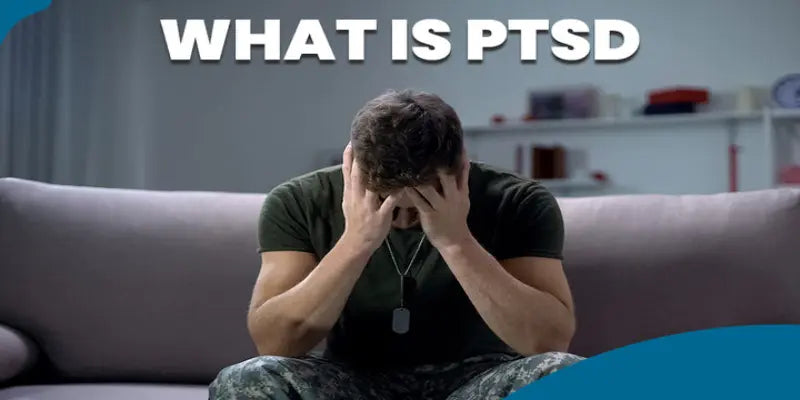
Symptoms - Post Traumatic Stress Disorder
Everyone has been affected by trauma in one way or another, whether it's a broken leg or being drugged and raped. PTSD is an anxiety disorder caused by a traumatic event. This article provides a basic overview of what PTSD is, including symptoms that can be present and how to get treatment for the disorder in order to live a happier and healthier life.
What is PTSD?
PTSD full form: Post Traumatic Stress Disorder is a mental health condition that is caused by experiencing or witnessing a traumatic event. This can be something as simple as a car accident, being in a combat zone, or being the victim of rape or child abuse.
PTSD can cause intense fear and anxiety, along with physical symptoms like insomnia, nightmares, flashbacks, and seizures. It can take months or even years for PTSD to develop after the traumatic event, but it's always possible to recover from PTSD if treatment is available. There are many ways to help treat PTSD, including therapy and medication. If you're experiencing PTSD symptoms, please seek help right away!
Symptoms of PTSD

Post-traumatic stress disorder (PTSD) is a mental health condition that can develop after exposure to a traumatic event. Symptoms of PTSD can include flashbacks, nightmares, intense memories of the event, avoidance of memories or reminders of the event, and feelings of anxiety or terror. PTSD can also cause problems with sleeping and eating.
PTSD can be caused by any type of traumatic experience, but it is most common following military combat or sexual assault. Other types of trauma that may lead to PTSD include car accidents, natural disasters, violence at home, and childhood abuse. Although everyone experiences different symptoms at different times, most people with PTSD experience some combination of the following:
- Flashbacks: Recollections or dreams about the traumatic event that are often very detailed and involve the original events or people involved.
- Nightmares: Dreams in which the individual relives the traumatic event over and over again with very vivid and frightening details.
- Intense memories: Memories of the event that are so overwhelming that they feel like they’re still happening. They may feel like they can’t forget what happened, and they may act out the events in dreams or flashbacks.
- Avoidance: The individual avoids activities or places that remind them of the trauma, even if it means missing out on important parts of their life. This can make it difficult to work or socialize.
The Stages of PTSD

Post-traumatic stress disorder (PTSD) is a serious mental health condition that can develop after exposure to a traumatic event. There are four main stages of PTSD, which are described below.
- Shock: In the first stage, known as shock, people may experience feelings of numbness and detachment from reality. They may also have trouble sleeping or eating and feel overwhelmed and scared.
- Reactive Fear: In the reactive fear stage, people may start to avoid anything that reminds them of the traumatic event. This can include places where they were involved in the traumatic incident, people who were associated with it, or things that remind them of the trauma itself. They may become hypervigilant and excessively worried about their safety.
- Internalizing Thoughts: People in this stage may start to worry about their own safety and well-being more than ever before. They might feel embarrassed or ashamed about what happened, as well as guilty for being alive when others were not. They may also lose interest in activities that used to be enjoyable.
- Externalizing Symptoms: In the externalizing symptoms stage, people may start acting out aggressively or self-destructively in response to the fear and anxiety they're feeling. They might develop problems at work or school, show signs of alcohol or drug abuse, or become aggressive towards loved ones.
Causes of PTSD
PTSD is a mental health condition that can be triggered by any traumatic event. It's most common after exposure to violence, such as rape or natural disasters, but can also occur after exposure to accidents or other events that make you feel scared or helpless.Post-traumatic stress disorder (PTSD) is a debilitating mental illness that can be caused by experiences like military combat, sexual assault, or car accident. While the cause of PTSD is still unknown, there are several potential causes and treatments for PTSD.
One possible cause of PTSD is a traumatic event that triggers memories and flashbacks of the event. Repeated exposure to these memories and flashbacks can lead to PTSD. Treatment for PTSD often focuses on gradually easing the individual back into their normal life while addressing any associated memories or flashbacks.
Another potential cause of PTSD is a combination of factors including genetics, environment, and prior trauma. If you have a family history of anxiety or depression, you’re more likely to develop PTSD after a traumatic event. Additionally, traumatic events can trigger flashbacks or other symptoms in people who are particularly sensitive to stressors. Treatment for PTSD centers around identifying and addressing these factors that may contribute to the development of the condition.
Also Read:- Sleep Disorders and Problems
Types of PTSD

Post-traumatic stress disorder (PTSD) is a mental health condition that can occur after exposure to a traumatic event. There are three main types of PTSD: acute, subacute, and chronic. Acute PTSD usually lasts for about two weeks and is the most common type. Subacute PTSD lasts for about six months and is often more severe than acute PTSD. Chronic PTSD can last for years or longer.
Acute PTSD usually occurs after a traumatic event that involves physical injury or death. Following an acute episode of PTSD, people may experience symptoms such as flashbacks, nightmares, hypervigilance, irritability, and re-experiencing the event in memories or dreams. They may also have trouble sleeping, eating, concentrating, or maintaining relationships.
Subacute PTSD is classified according to the duration of its symptoms: short-term (lasting less than one month), medium-term (lasting one to six months), or long-term (lasting more than six months). People with short-term subacute PTSD may have few if any symptoms following a traumatic event, while those with long-term subacute PTSD may experience frequent symptoms and difficulties functioning.
Chronic PTSD typically develops after prolonged exposure to trauma beyond the normal range of experiences for someone who has not been exposed to trauma before. This type of PTSD can lead to significant problems in everyday life such as anxiety, insomnia, joblessness, and impaired social interactions.
Also Read:- Circadian Rhythm Disorders: Types, Symptoms, Diagnosis & Treatment
Treatment for PTSD: Psychotherapy, Medications and More
PTSD is a serious mental health condition that can be caused by any type of traumatic experience, such as combat, sexual assault, car accidents, or natural disasters.
There is no one “right” way to treat PTSD. Treatment depends on the individual and the severity of their symptoms. Some common treatments include therapy, medication, and self-care techniques.
Therapy is often the first step in treating PTSD. It helps individuals explore their memories and experiences from the trauma, learn how to cope with stress, and develop new skills to live a healthy life.
Medication can also be helpful for treating PTSD. Doctors may prescribe antidepressants or benzodiazepines (anti-anxiety medications) to help relieve symptoms such as anxiety, depression, insomnia, and flashbacks.
Self-care techniques are important for anyone suffering from PTSD. This includes activities like relaxation exercises and journaling to help manage stress and memories from the trauma.
If you are experiencing PTSD, it is important to speak with a therapist experienced in treating the disorder. Exposure therapy and cognitive restructuring are two common types of psychological treatment used to help people learn how to manage their thoughts and feelings about traumatic events.
Medications also play an important role in treating PTSD. Antidepressants, anti anxiety medications and antipsychotic medications can all help relieve symptoms of PTSD. It is important to discuss your treatment options with your doctor before beginning any new course of treatment.
Outlook for PTSD in the Future

PTSD is a serious mental health condition that can occur after experiencing or witnessing a traumatic event. It's often characterized by intrusive memories and thoughts, increased anxiety and stress, and recurring nightmares or flashbacks. PTSD can significantly disrupt your life, cause major depression and anxiety, and make it extremely difficult to function in everyday activities. However, thanks to advances in medical research, there is hope that PTSD will be better understood and treated in the future.
There are many different treatments available for PTSD, including therapy, medication, and self-care strategies. Treatment typically involves a combination of these methods, depending on the person's individual needs. Some people find relief from treatment quickly while others require more time or multiple sessions. Regardless of how long it takes to recover from PTSD, everyone deserves help in getting back to their lives as fully as possible.
Conclusion
Post traumatic stress disorder (PTSD) is a condition that can affect people after experiencing a traumatic event. Traumatic events can include anything from military combat to sexual assault. Symptoms of PTSD can vary depending on the person, but they generally include intense memories and flashbacks, negative thoughts and feelings about oneself or the event, difficulty sleeping or concentrating, and having extreme anxiety or fear. If you are worried that you may be suffering from PTSD, it is important to seek help. There are many resources available to those who need them, including support groups and therapists.








